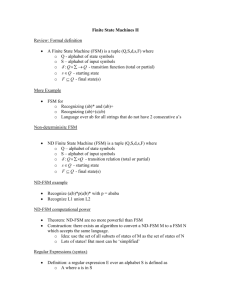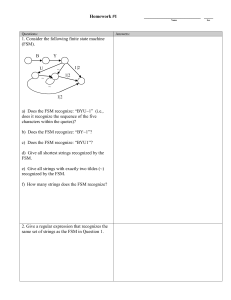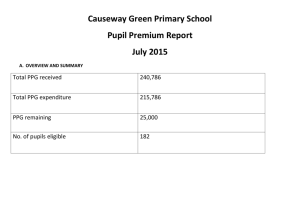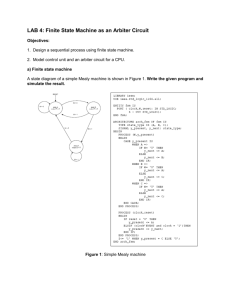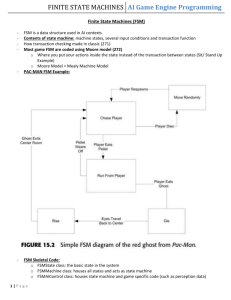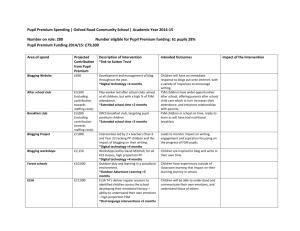Exam_03_Solutions
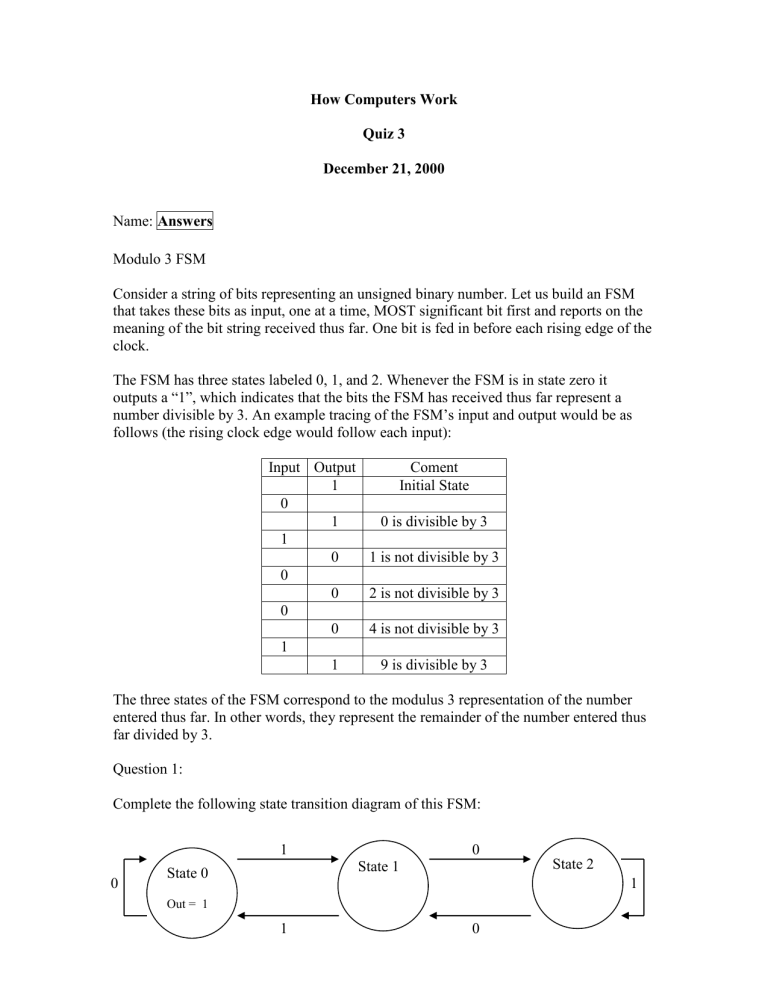
How Computers Work
Quiz 3
December 21, 2000
Name: Answers
Modulo 3 FSM
Consider a string of bits representing an unsigned binary number. Let us build an FSM that takes these bits as input, one at a time, MOST significant bit first and reports on the meaning of the bit string received thus far. One bit is fed in before each rising edge of the clock.
The FSM has three states labeled 0, 1, and 2. Whenever the FSM is in state zero it outputs a “1”, which indicates that the bits the FSM has received thus far represent a number divisible by 3. An example tracing of the FSM’s input and output would be as follows (the rising clock edge would follow each input):
Input Output
1
0
1
Coment
Initial State
0 is divisible by 3
0
1
1
0
0
0
0
1 is not divisible by 3
2 is not divisible by 3
4 is not divisible by 3
1 9 is divisible by 3
The three states of the FSM correspond to the modulus 3 representation of the number entered thus far. In other words, they represent the remainder of the number entered thus far divided by 3.
0
Question 1:
Complete the following state transition diagram of this FSM:
State 0
Out = 1
1
State 1
0
State 2
1
1 0
Question 2:
This FSM indicates that if n mod 3 = x (i.e. the remainder of n divided by 3 is x), than (2 n + 0) mod 3 = y and (2 n + 1) mod 3 = z . Fill in the following table for x, y and z. This table should help you check your answer to question 1.
X Y Z
0 0 1
1 2 0
2 1 2
Question 3:
If you answered question 1 properly, you will note that your FSM is symmetric.
What do you think this means if you fed in the bits of a number n least significant bit first instead of most significant bit first? If n were divisible by 3, would the bit-reverse of n also be divisible by 3? Explain why or why not.
Since the incoming and outgoing arrows for each state are symmetric, the machine yields the same result if you run it in either direction. So, sending in the bitreverse of n will yield the same final state.
The combinational circuit below is made up of smaller combinational logic blocks, each of which has and a t pd of 5 ns . The arrows indicate direction of data flow. All
Data is presented to the inputs of this circuit simultaneously.
Question 4:
What is the tpd of the entire circuit?
35 ns
Question 5:
Assuming no pipelining is used, what is the Throughput of the entire circuit?
1/35ns
Question 6:
Carefully draw lines through the circuit above the show how to pipline the circuit for correct operation and maximum throughput using a minimum number of registers.
Place a register on the outputs, and assume all inputs come from the output of registers of preceding logic. Hint: You may want to first re-draw the circuit below so that all arrows have a general left-to-right direction (as well as some also have up or down directions), thus insuring that data always flows from left to right, and then draw the register lines on the drawing below.
Question 7:
If the circuit is correctly pipelined for maximum throughput using ideal (zero delay, zero setup / hold time) registers, what is its resulting latency and throughput? Show your calculations
Latency = 35 ns, throughput = 1/5 ns
Question 8:
What is the latency if non-ideal registers are used that have t pdCLK-Q
= 2 ns, t cdCLK-Q
= 1 ns, t setup
= 1 ns, and t hold
= 3 ns?
Latency = 7(Tpdcq + Tpd + Ts) = 56ns
Question 9:
What is the minimum logic block t cd
required to guarantee that the non-ideal system works correctly?
Tcd = Th – Tcdcq = 2ns
Recall that the naive implementation of the 4 state Beta pipeline has 2 branch delay slots
(i.e. 2 instructions following a branch are executed because they’ve already been prefetched before the PC is written).
Consider the following bizarre fragment of code, which contains branches in the branch delay slots:
Line 1: br (a)
Line 2: br (b)
Line 3: br (c) a: Instruction A1
Instruction A2
Rest of A instructions b: Instruction B1
Instruction B2
Rest of B Instructions c: Instruction C1
Instruction C2
Rest of C Instructions
Question 10: Indicate which of the above instructions will be executed, and in what order.
Line 1
Line 2
Line 3
A1
B1
C1
C2
Rest of C Instructions
Consider now the task of building a frequency discriminator, i.e. a device that can take two square waves and output a measure of their difference in frequency.
Let us say we desired a device that will take two input square waves A, and B, and output a waveform on an output wire named “A>B” which is “1” some of the time and “0” the rest of the time. The fraction of the time the “A>B” output is 1 will indicate how much the frequency of A exceeds that of B. In a similar way, another output line “B>A” will be
“1” some of the time and “0” all other times. If the frequency of B is greater than the frequency of A, the “B>A” output will be “1” a fraction of time proportional to the degree to which the frequency of B exceeds that of A.
It is your job to design a circuit to accomplish this. To help you along, we will describe the architecture to be used as that of a first FSM advancing, at clock rate A, like a wheel with 4 numbers painted around its face. A second FSM will take strobe pictures at clock rate B of the first FSM’s output wheel. If the two clock rates are equal, each successive picture by the second FSM should be of an increasing number of the first FSM’s output wheel. If the clock rates are unequal, some pictures will be of the same number on the wheel or some successive pictures will skip a number.
Let us suggest first that you use the A input to clock a 2 bit finite state machine “wheel” that will count in grey code (i.e. 00, 01, 11, 10). Take the output of this grey code FSM, and use it as input to another “strobe” FSM that is clocked by the B input.
Besides the B clock, the “strobe” FSM has two inputs (the outputs of the first FSM), two outputs (A>B, B>A) and four states.
Question 11:
In the space below, complete the state machine diagram of this second FSM by filling in the conditions and outputs for the arrows. Recall that the idea is that the two outputs should be zero if both the A and B clocks have identical frequency and should be 1 a proportionate fraction of the time that one clock frequency exceeds the other.
00,B>A
01,B>A
00
00,A>B
01
11,A>B
>
01
10,A>B
B
00
01,A>B
>
11
10
01,A>B
B
00,A>B
11
11,A>B
>
11,B>A
10
10,B>A
Question 12: How much can the frequency of A exceed the frequency of B while still giving a correct response?
3 times
Question 13: How much can the frequency of B exceed the frequency of A while still giving a correct response? infinite
Question 14: Since the two FSMs have different clocks, in order to reduce the problem of metastable states, an extra 2 bit register is placed between the first and second FSMs, clocked by the second FSM’s clock (B). Ben BitDiddle decides that the best behavior of the register is for it to refraim from changing its output bits until after any metastable states have resolved. Is it theoretically possible to build such a register?
Yes. You can detect metastability; You just cannot resolve it in finite time.
Question 15: Assuming it was possible to build such a register, its effect would be to possibly delay transitions on its output by a certain amount. While such delay may temporary cause the strobe FSM to generate the wrong output, is it likely the average output of the strobe FSM will be adversely affected? Explain why or why not:
No. Since, on average, metastable states will not happen often, individual events will have little effect on the average.
Question 16: Explain why a grey code instead of a binary code was used for the “Wheel” of the first FSM.
In the grey code, only one bit changes at a time, which prevents hazards and cuts down on the possibility of metastability.



